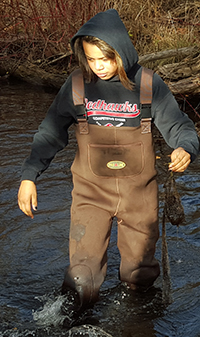The water is cold. The leaves and sticks are slimy. And then there are the bugs.
“It’s disgusting. There are teeny, tiny creatures crawling,” Cedar Springs High School freshman Abby Scott said while peeling through a leaf pack looking for life.
Science isn’t always tidy, but at least this time it was productive.
Freshmen and sophomore students in a pair of biology classes took to Cedar Creek recently to retrieve two dozen leaf packs planted in mid-October.
“We came out four weeks ago, put leaves in these mesh packs and anchored them in the stream in two locations,” science instructor Eddie Johns said. “Whatever micro-invertebrates they pull out will tell us some things about the ecosystem. These profiles can be measured against coming years and compared with waterways in other areas.”
More information is needed, but early indicators confirm what teachers and students expected to find from their research: namely, that waters adjacent to undeveloped creekside land is healthier for its tiny inhabitants and our greater ecosystem than the waters adjacent to cut timber and planned development.
The effort was organized by Trout Unlimited, a 57-year-old organization formed on the banks of the Au Sable near Grayling. It works with anglers, wildlife experts, municipalities and students to ensure Michigan waterways are and remain stable for native fish life and other natural inhabitants.
“This is a good area to gauge impact because there is a new library and amphitheater planned for this area,” said Nichole DeMol, a project manager for Trout Unlimited. “A lot of what we look at is how runoff affects ecosystems. How does that runoff affect this stream versus others?”

Field Experience Beats Classroom
Students formed 24 groups of three, placing and recovering a pair of leaf packs per group. Each pack was half-filled with leaves and anchored to a spot that would provide an anticipated differing outcome from the other pack. For instance, some teams placed a pack both upstream and downstream from a stormwater drain. Some used opposing banks of the creek, while others anchored to a live tree and cut wood for contrast.
“We got a crayfish and a caterpillar,” freshman Thomas Eason said. “We’ll put them all under a microscope tomorrow and see what else we have.”
Biology teacher Steve Vree said the field experience is an eye-opener for students. Some students made mistakes thataffected results, learning lessons that can be applied in future field outings. Others were surprised that so much could be learned about the creek from a two-day exercise.
“There are some experiences you can gain in the field that simply cannot be replicated in a classroom, or with pen and paper,” Vree said.
After the field and lab work, students provided an oral presentation of their findings. Vree said he anticipated a final project related to the outing, perhaps comparing water quality data from Cedar Creek to other nearby waterways, possibly in Sparta or Rockford, where Trout Unlimited also is working.
Cedar Creek data will be uploaded to the Leaf Pack Network where several hundred students from across the country have shared their stream quality scores.
Ebonye Hunter was one of the Cedar Springs students designated to wade in the creek for leaf packs.
“It was cold,” she said. “But it was worth it.”
CONNECT









